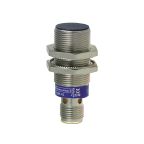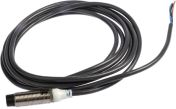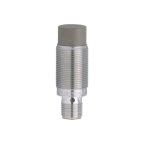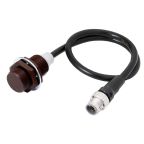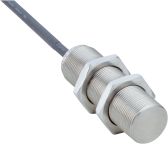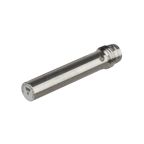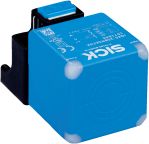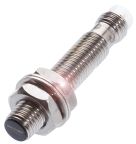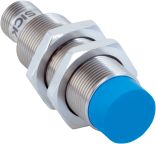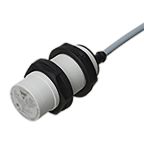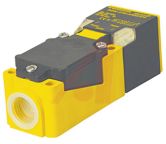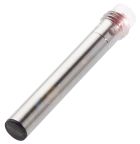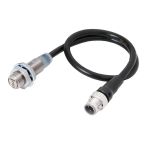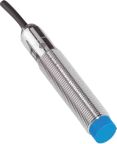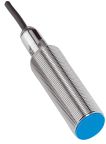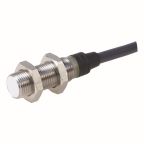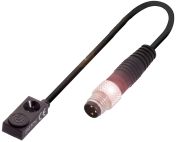Proximity Sensors
Proximity sensors are indispensable tools in modern automation and safety systems, designed to detect the presence or absence of objects without direct contact. Utilised across various sectors, these sensors provide critical data that enhances process efficiency and safety, enabling machines and systems to react to their environments with high precision.
What is a Proximity Sensor?
A proximity sensor is a non-contact component designed to detect the presence or absence of an object without physical contact. It offers a valuable solution for working with delicate or unstable objects. Proximity sensors have key features and benefits, including motion detection of metallic and non-metallic objects, wide temperature range (-50°C to 100°C), high-speed motion sensing without contact, usability in applications with oil or water, and quicker response times compared to contactors.
Types of Proximity Sensors
There are various types of proximity sensors suitable for different applications. They operate based on a universal working principle and transmit data about object presence or motion via an electrical signal when the object is within the sensor's range.
Here are some common types:
Infrared Sensors (IR Sensor)
- Passive Infrared Sensors (PIR): Utilise pyroelectric infrared sensors within a magnetic lens to detect changes in the signal caused by object movement.
- Active Infrared Sensors: Employ an IR LED to emit an infrared beam received by an infrared detector, identifying obstacles that block this radiation.
Inductive Proximity Sensors
Inductive proximity sensors generate an electromagnetic field through an oscillating circuit. Any ferrous metal object, including aluminium, copper, brass, and iron, triggers a change in the oscillation, indicating its presence.
Capacitive Proximity Sensors
Capacitive sensors can detect various shapes and materials from a distance, even through non-metallic walls. They are suitable for use with non-ferrous materials and find applications in close-range tasks like level detection and monitoring.
Ultrasonic Proximity Sensors
Ultrasonic sensors emit and receive high-frequency sound waves that can be reflected or absorbed by objects within their range. These sensors are ideal for high-speed and long-distance measurements, such as wind speed, fluid level, and speed through air or water.
Magnetic Proximity Sensors
Magnetic proximity sensors detect the presence or absence of an object using an external magnetic field. These sensors activate when a magnet moves a reed switch to the ON position, indicating the presence or absence of an object.
Advantages of Proximity Sensors
- Good Stability: Reliable performance in a variety of applications.
- High Speed and Switching Rate: Ideal for rapid detection needs.
- Harsh Environment Operation: Functions effectively under tough conditions.
- Low Cost and Power Consumption: Economical to purchase and operate.
- Enhanced Security: Addresses a range of security challenges effectively.
Features of Proximity Sensors
- Non-Contact Detection: Detects objects without physical contact, avoiding abrasion or damage.
- Long Service Life: Utilises semiconductor outputs without mechanical contacts, enhancing durability.
- Resistant to Contaminants: Operates effectively in environments exposed to dirt, oil, and water, with certain models offering enhanced chemical resistance due to fluororesin cases.
- High-Speed Response: Offers quicker operational response compared to mechanical switches.
- Wide Operating Temperature Range: Functions across a broad temperature spectrum from -40 to 200°C.
- Colour Insensitivity: Detects objects regardless of colour, focusing on physical changes rather than surface characteristics.
- Environmental Influence Considerations: Installation requires careful planning to avoid interference from ambient temperatures, surrounding objects, and other sensors.
- Two-Wire Configuration: Combines power and signal lines, requiring a load to avoid damage to internal elements.
Applications of Proximity Sensors:
- Standard Object Position Detection: Used extensively for detecting the position of objects along production lines to ensure proper alignment and assembly.
- Transportation, Logistics, and Supply Chain: Enhances efficiency by monitoring and managing the movement of goods in warehouses and distribution centres.
- Inspection and Quality Assurance: Crucial for verifying product quality and consistency without direct contact, reducing the risk of damage.
- Process Control: Integral to automated systems that control various industrial processes, ensuring operations proceed without interruption.
- Level Detection: Commonly used in tanks and silos to measure levels of liquids and solids, crucial for industries such as chemicals and beverages.
- Food Processing and Manufacturing: Ensures the safe and hygienic handling of food products by minimising direct contact.
Ordering and Delivery Information
Placing an order for your proximity detectors with RS is simple and flexible. For the fastest and most convenient service, order online to browse and add products to your basket for next-day delivery or local branch pickup. You can also place your order by calling us at +65 6865 3400. When ordering online, just choose your items, set the quantities, and select your preferred delivery options, which include immediate dispatch or scheduling a forward order for a later date.
For a comprehensive overview of all our delivery options, delivery information page.
Popular Searches
Related links
- TSSP94038 Vishay, Infrared Proximity Sensor
- Lascar Contactless Switch Series Infrared Proximity Switch 22 → 23mm Cutout Red LED, 9.6 →
- Lascar Contactless Switch Series Infrared Proximity Switch 22 → 23mm Cutout 9.6 →
- Lascar Contactless Switch Series Infrared Proximity Switch Red/Green LED IP67
- Lascar Contactless Switch Series Infrared Proximity Switch 22 → 23mm Cutout IP67
- Carlo Gavazzi Capacitive Barrel Ultrasonic Sensor 6000 mm Detection 18 → 30 V dc
- ifm electronic Capacitive Rectangular Proximity Sensor PNP NO/NC, 10 → 36 V dc
- ifm electronic Capacitive Rectangular Proximity Sensor PNP NO, 10 → 36 V dc
